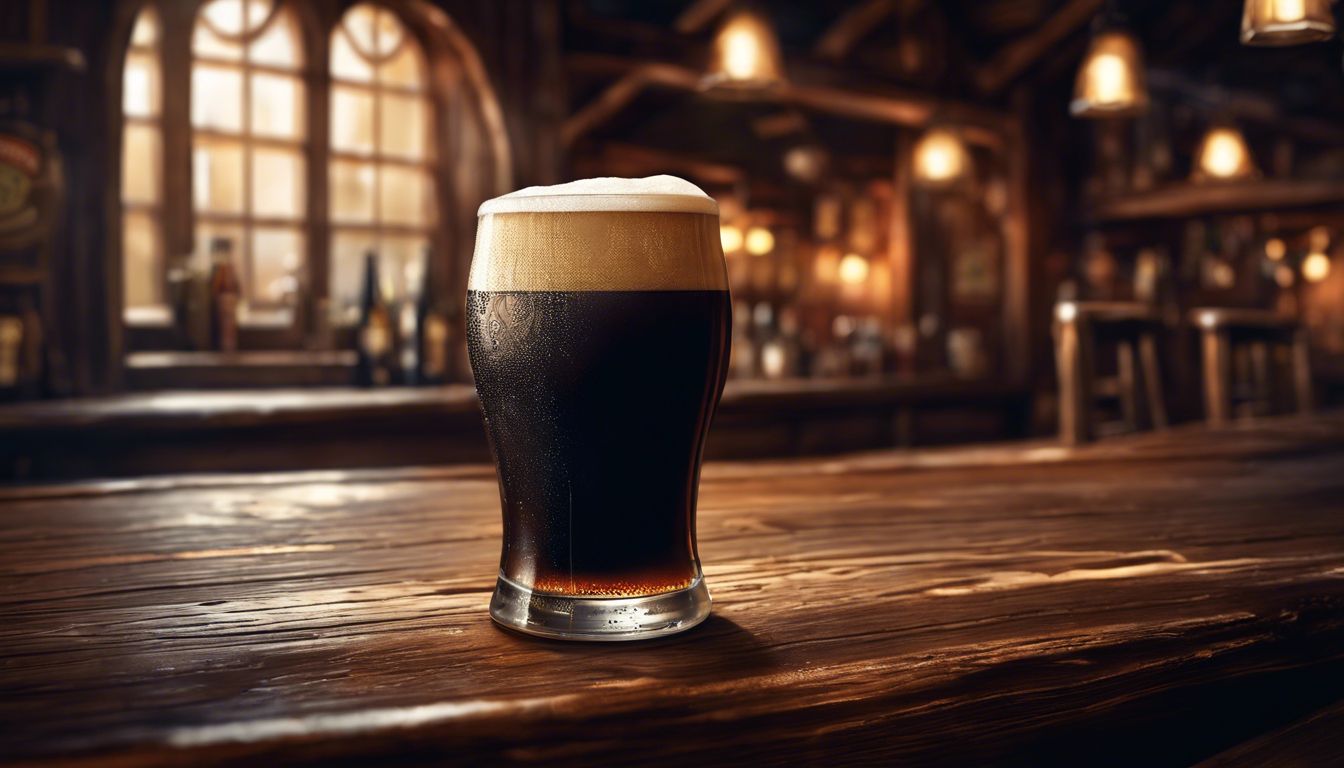Exploring the Flavors: What Does Guinness Taste Like?
Guinness is a famous dark beer known around the world. It looks rich and has tastes of roasted malt, chocolate, and coffee. People enjoy its creamy foam on top, which comes from using nitrogen.
This makes Guinness smooth to drink. The water used and where it’s made can change how it tastes. Chefs like to cook with Guinness because it adds deep flavors to dishes like stews and cheeses.
Some people may not like the taste at first but often grow to love its unique flavor over time.
You’ll find Guinness at many parties, especially on St. Patrick’s Day due to its Irish roots. Its special look and taste come from smart brewing methods that even include non-alcoholic versions today.
Explore with us as we dive into what makes Guinness so special!
Key Takeaways
- Guinness has a malty sweetness and hoppy bitterness with notes of coffee and chocolate. Its roasted flavor is key to its taste.
- The beer’s special canned process adds nitrogen, giving it a creamy texture. Water from the Wicklow Mountains and brewing in multiple locations affect its unique flavor.
- Guinness can be used in cooking to enhance stews, rubs, and sauces, or add depth to dishes like beer cheese.
- While newcomers might initially find Guinness too strong or bitter, many grow to enjoy its distinct flavors over time.
- St. Patrick’s Day celebrations often feature Guinness due to its Irish heritage and popularity during the event.
The Taste of Guinness: What You Should Expect
Guinness offers a unique blend of malty sweetness, hoppy bitterness, and notes of coffee and chocolate. The roasted flavor adds depth to the overall taste experience.
Malty sweetness
Guinness delights with a malty sweetness that comes from its rich dark roasted malt. This smooth, sweet flavor mixes well with the beer’s overall complexity. It sets the stage for other tastes and aromas to dance on your tongue.
As you sip, this initial sweetness lingers just enough before blending into the deeper bitter notes. It gives Guinness its signature balance that stout lovers appreciate. Many describe it as akin to caramel or a subtle hint of bread – comforting, familiar flavors that bring warmth to each mouthful.
Hoppy bitterness
Transitioning from the malty sweetness to the hoppy bitterness of Guinness, you’re met with a robust yet balanced flavor profile. The beer’s hoppy bitterness adds a pleasing complexity that enhances its overall taste.
This bitterness is notable but not overpowering, offering a harmonious contrast to the beer’s malty sweetness and roasted notes. It complements the other flavors, adding depth to your drinking experience without dominating the palate.
Notes of coffee and chocolate
Guinness boasts distinct notes of coffee and chocolate, adding depth to its rich, malty sweetness. The roasted flavor profile delivers a satisfying blend of dark coffee and cocoa undertones, contributing to the beer’s unique allure.
This combination creates an appealing taste experience for those seeking a harmonious balance of bitter and sweet flavors in their brews. With its infusion of complex aromas, including hints of roasted coffee and chocolate, Guinness captures the essence of indulgence within every sip.
Roasted flavor
With its distinct notes of coffee and chocolate, Guinness also offers a prominent roasted flavor. This deep, rich taste is derived from the roasted malt used in the brewing process.
The roasty essence adds depth to the overall profile of the beer, complementing its malty sweetness and hoppy bitterness. When enjoying Guinness, you can expect to savor this unique combination of flavors that contribute to its iconic stout character.
The use of high-quality roasted malt gives Guinness its signature dark appearance and robust taste. When experiencing the roasted flavor, you’ll notice a delightful balance between bitter undertones and a smooth finish, creating an indulgent drinking experience.
Factors Affecting the Taste of Guinness
The special canned process, water source, and brewing location all play a role in the unique taste of Guinness. Read on to explore how these factors contribute to the flavors of this iconic beer.
https://www.youtube.com/watch?v=HzXDz7bT4Lc
Special canned process
Guinness uses a special canned process that involves the injection of nitrogen and carbon dioxide to create its signature creamy texture and smooth taste. This unique method creates smaller bubbles compared to regular carbonation, adding to the beer’s distinctive mouthfeel and flavor profile.
The result is a velvety head and a perfect balance of bitterness, sweetness, and roasted notes in every sip, making it an iconic feature of Guinness Draught Stout that enthusiasts appreciate.
The special canned process injects nitrogen and carbon dioxide to develop Guinness’s creamy texture and smooth taste. With smaller bubbles than regular carbonation, this method contributes to the beer’s unique mouthfeel and flavor profile.
Water source
After considering the special canned process, it’s essential to understand that the water source also significantly contributes to Guinness’ distinctive taste. The natural spring water from the Wicklow Mountains is used in brewing Guinness.
This unique water source helps create the smooth and balanced flavor profile of this iconic stout, enhancing its malty sweetness and harmonizing with its roasted notes.
The quality of the natural spring water from Wicklow Mountains plays a crucial role in shaping the flavors of Guinness. Its infusion into the brewing process adds to the distinct taste that enthusiasts have come to love and appreciate.
Brewing location
Guinness’s unique taste is also influenced by its brewing location. The beer giant has breweries in 49 countries, but the heart of Guinness production remains at the St. James’s Gate Brewery in Dublin, Ireland.
This iconic brewery, where it all began, plays a crucial role in maintaining the quality and essence of Guinness Draught. Additionally, each brewery location aims to ensure that every pint poured around the world upholds this revered taste.
The specific locations where Guinness is brewed are strategically chosen for their water sources close to Dublin’s original soft water profile. Moreover, these locations maintain consistent temperature conditions critical to retaining the unique flavor that defines Guinness stout globally.
Using Guinness in Cooking
Enhance the flavors of stews and rubs with Guinness, or create a delicious beer cheese using this iconic Irish ale.
Flavor enhancement in stews and rubs
Guinness enhances the flavor of stews and rubs with its rich, roasty profile. When added to beef or lamb stews, it contributes a deep malty sweetness and subtle hoppy bitterness, complementing the savory meat flavors.
The notes of coffee and chocolate add complexity to the dish, creating a delicious depth that pairs well with hearty ingredients. Additionally, in dry rubs for barbecued meats, Guinness brings a unique balance of roasted flavors while helping to tenderize the meat.
The use of Guinness in cooking offers an opportunity to infuse dishes with its distinctive tastes without overpowering other ingredients. Whether simmered in a stew or used as part of a marinade, Guinness adds a nuanced richness that elevates traditional recipes into memorable culinary experiences.
Beer cheese
Considering the rich, roasty flavor of Guinness, it is no surprise that it makes an excellent addition to beer cheese. Its malty sweetness and hoppy bitterness enhance the overall taste, while its notes of coffee and chocolate add depth to the dish.
The creamy texture and dark ruby red appearance complement the flavors in beer cheese, making it a popular choice for many Irish culture enthusiasts. Using Guinness in beer cheese provides a unique twist to this classic recipe, elevating it with distinct flavors and giving it a nod to traditional Irish brewing techniques.
Wider Perceptions of Guinness
First-time drinkers may initially dislike the taste of Guinness, but it often evolves into a favorite for beer enthusiasts. Its adaptability in various recipes and popular associations with events like St.
Patrick’s Day make it a unique and beloved drink.
Initial dislike for first-time drinkers
First-time drinkers often dislike the distinctive taste of Guinness due to its strong roasted flavor, malty sweetness, and hoppy bitterness. Some may find it overwhelming if they are not accustomed to dark beers with coffee and chocolate notes.
However, over time, many develop a taste for its unique flavor profile and creamy texture that sets it apart from other beers.
Moving on to the factors affecting the taste of Guinness..
Evolution of taste for beer enthusiasts
As beer enthusiasts delve deeper into the world of brews, many discover a newfound appreciation for the unique taste of Guinness. Over time, palates evolve to embrace its malty sweetness and hoppy bitterness, alongside the distinct notes of coffee and chocolate.
As they savor this iconic stout, enthusiasts come to appreciate its adaptability in various recipes and recognize its association with special occasions like St. Patrick’s Day. Through evolving perceptions and culinary explorations, Guinness becomes more than just a beverage; it transforms into an integral part of their beer experiences.
Guinness’ evolution among beer enthusiasts coincides with their exploration of flavors beyond conventional brews. The distinctive richness and roasted flavor initially disliked by some first-time drinkers gradually become cherished attributes as they develop a fondness for under-extracted coffee notes in the popular Irish stout.
Adaptability in various recipes
Guinness is versatile in cooking. It enhances the flavors of stews and barbecue rubs, adding a rich and robust dimension to the dishes. The beer’s distinctive taste, with hints of coffee and chocolate, makes it an excellent ingredient for creating unique beer cheese recipes that stand out.
Additionally, its adaptability extends beyond savory dishes into sweet treats like desserts, where the malty sweetness complements ingredients such as chocolate or caramel exceptionally well.
Popular associations with Guinness (e.g. St. Patrick’s Day)
St. Patrick’s Day is one of the popular associations linked with Guinness, where celebrations include raising a pint of this iconic Irish stout. The rich and robust flavor of Guinness complements traditional Irish dishes served during the festivities, creating a perfect pairing for the occasion.
Its presence has become an integral part of celebrating the culture and heritage that St. Patrick’s Day represents among enthusiasts who appreciate its distinct taste and cultural significance.
Remember to savor its unique flavor, which enhances the spirit of St. Patrick’s Day celebrations, enriching the experience for those drawn to Irish culture and traditions.
Unique branding and marketing strategies
Guinness has mastered the art of branding and marketing, leveraging its rich Irish heritage and iconic status. The brand uses St. Patrick’s Day, a globally celebrated event, as a platform to reinforce its Irish roots and appeal to a wider audience.
Additionally, Guinness has successfully positioned itself as more than just a beer through innovative campaigns that emphasize community engagement and cultural significance, establishing it as an integral part of Irish culture both at home and abroad.
Moreover, Guinness has effectively utilized its distinct flavor profile to shape its branding by highlighting the unique taste experience in its marketing efforts. By focusing on the tasting notes such as malty sweetness and hoppy bitterness while integrating concepts like under-extracted coffee into their narrative, Guinness manages to captivate consumers’ attention and solidify its position in the market as an unparalleled stout with deep-rooted Irish traditions.
Conclusion
In conclusion, Guinness offers a unique flavor experience with its malty sweetness and hoppy bitterness. Its notes of coffee and chocolate, along with the roasted flavor, make it distinctive.
Whether enjoyed as a drink or used in cooking, Guinness is a versatile ingredient that can enhance various dishes. Embracing diverse perceptions and associations, this iconic beer continues to captivate both enthusiasts and curious first-timers alike.
Cheers to savoring the rich flavors of Guinness!
FAQs
1. What flavors can I expect from Guinness beer?
Guinness beer has a rich and complex flavor that includes hints of coffee, chocolate, and roasted barley.
2. Is Guinness like other draft beers?
Yes, like other draft beers, Guinness is served fresh from the tap but it also has a unique creamy texture.
3. Can you compare the taste of Guinness to anything else?
The taste of under extracted coffee, which is strong and slightly bitter, can be similar to notes in Guinness.
4. Will Guinness taste different if it’s not on draft?
While still flavorful in bottles or cans, Guinness often tastes best on draft where its full creaminess can be enjoyed.
Hello! I’m Ryan Nelson, the heart and soul behind IrishGraves.com. Born in New York City with a rich blend of Irish and Scottish heritage, I’ve always felt a deep pull towards exploring my roots and understanding the cultures that shape me. This passion ignited my journey to Ireland, a land of breathtaking landscapes, profound history, and vibrant culture, leading to the creation of IrishGraves.com.







